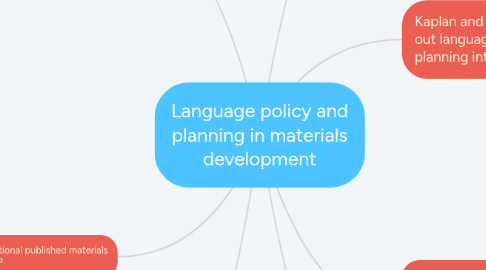Language policy and planning in materials development
by Mohinur Ernazarova


1. Language policy divided into two levels: Macro-level (governmental level) Micro-level (individuals or groups of language behaviours)
2. Kaplan and Baldauf (2003) parted out language-in-education planning into interrelated areas:
2.1. access policy plans - dealing with choice of languages on the curriculum
2.2. personnel policy planning - deals with the recruitment and training of educators
2.3. curriculum policy -decides on the organization and content of the curriculum
2.4. materials and methods policy - concerns with pedagogic resources
2.5. recourcing policy - allocates funding
2.6. community policy-engages local communities
2.7. evalution policy - measures and judges above mentioned policies
3. An analysis of the secondary-level English textbooks in Pakistan (Aftab, 2012) reveals number of recommendations in evaluation of systematic nature in language-in-education policy:
3.1. matching learners' needs and wants for their future job requirements
3.2. greater involvement of school adminstrators
3.3. teachers and students in planning
3.4. a flexible curriculum adaptable for local contexts
3.5. the training of local materials writers
4. successful implementation of language policy was suggested by Swanson and Bargwhal (2009). They offered seven tools to create adaptive policies to local change contexts:
4.1. understanding the context and the issues in operation of new policy
4.2. selecting suitable indicators of performance to evaluate policy success
4.3. predicting scenarios and ensuring that policy can be adjusted in process of designing policy
4.4. systems need to be set up that provide continuous reviews of implementation in policy improvement
4.5. adaptive approach will provide flexibility and variation depending on local conditions
4.6. A backward-mapping ( quite useful to evaluate policy implementation) reserves forward-mapping approach that moves form microto macro with investigation of the local context
4.7. policies sometimes conflict with accepted pedagogic practice and compromises are made both materials developers and teachers in the classroom
5. International published materials and LPP
5.1. six evaluation of global coursebooks
5.1.1. helping to develop creative thinking
5.1.2. helping todevelop critical thinking
5.1.3. helping to develop communicative competence
5.1.4. catering for students in both rural and urban areas
5.1.5. providing a window on the world
5.1.6. new policies are sometimes insufficiently understood or accepted by the personnel in Minstry of Education
5.1.7. contributing to educational development
